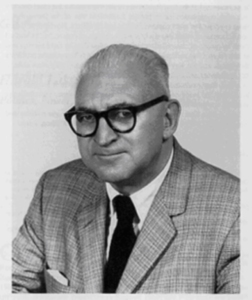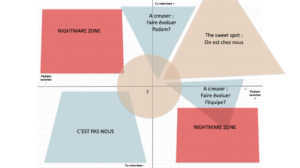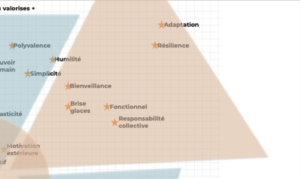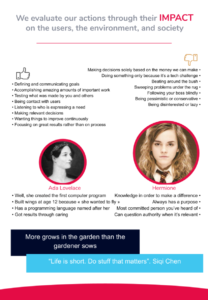Step 1 – mapping the concepts
Step 2 – ensuring alignment
Step 3 – synthesizing information gathering
Step 4 – involve everyone in the staging.
As a preamble to the document that presents its corporate culture, Netflix reminds us that Enron – a multinational that disappeared after a historic financial scandal – had the following values: Integrity, Communication, Respect, and Excellence.
How can we ensure that company values correspond to reality? That they will be lived on a daily basis, and that they support both the vision and the mission?
Today we share our methodology, hoping that you will improve it, and share your improvements with us #share
Where do the values fit in our approach?

Harold Laswell (opposite), the grandfather of corporate communication, defines marketing in the following way: Who says what to whom through which channel for what effect. Values are at the heart of the Who. They will therefore be deployed throughout the model, right up to the effects.
The importance of values in the success of a company has been detailed and popularized by Collins and Porras in Built to last, a must-read for every leader.
Above all, our values are benchmarks that define the right way to act.
Step 1 – individual interviews: mapping the concepts
It is a person recently arrived in the company who carried the approach. With a fresh and naive look, not much parasitized by historical biases. An individual interview with each employee brought out a list of trends and key words, by asking questions such as :
• What best represents Padam Mobility?
• Why is this company incredible?
• What part of your personality exists in Padam Mobility?
• When something works at Padam Mobility, what is it thanks to ?
• And when it doesn’t work ?
• What impresses you most about your colleagues? What do they miss?
• What surprised you when you arrived?

The size of the expressions represents the frequency with which they were heard.
If there are only a few of you, you can interview each employee. Beyond 30 or 40, you can focus on historical employees, founders, or very recent arrivals. Those who are not in an in-between situation. You can also send a questionnaire to the entire company.
A synthesis will come up with a list of concepts, carried by one or more people. It is then necessary to define sharp values and avoid a list of good intentions. We wanted values that pass the Bullshit detector. So we gave each value a positive opposite.
For example, to rigor we opposed elasticity. To strength we opposed finesse, to action we opposed reflexion, etc.
The bullshit detector consists of evaluating the impact of a message by asking whether it is opposable. That is, whether someone is defending the opposite of what you say. If not, the message is empty.
For example, “I want to bring unemployment down” does not pass this test because nobody wants it to go up. It’s not a memorable message. “I want to bring down unemployment for the over-55s through assisted contracts over a 5-year period” passes this test with flying colours: others will want to use opposite methods.
Step 2 – The survey: ensuring alignment
We then carried out a survey to all the staff, asking about the values that emerged during the interviews. The survey proposed to place ourselves on an axis between two opposite but positive values. By proposing to each person to evaluate the one they value the most, and the one the company values the most.
Between benevolence and high demands. Between individual responsibility and collective responsibility, between versatility and specialization.
It is essential to ask the teams what the company values. To ensure that management and leadership will embody the values. It would be disastrous to end up with values that only represent the wishes of the teams. And it would be just as disastrous to end up with values that only express the desires of management.
We are efficient because we believe in the values of our mission, both ecological and social. At the core of our action, it is human considerations which welds us on a daily basis. This is where the collective desire to overcome any problem on our path comes from, and the energy deployed to solve it”. Benoit – CTO
18 x2 questions that allowed us to place each of the values and its inverse on axes. Don’t expect your employees to jump for joy, it wasn’t the most exciting part of the process.
But the data collected allowed us to map out our key words and start taking action.
Step 3 – Results and mapping: synthesizing information gathering
This phase took place during an off-site All staff meeting. The right time for the exercise to become collective.
It was therefore a question of placing the results of the survey on a mapping with the following axes:
- Valued by the employees (+/-)
- Valued by the company (+/-)

Nightmare zones are the bad news: when Padam Mobility and its employees do not agree on the importance of certain values.
Bottom left, what does not represent us: what Padam Mobility and its employees do not value.
The blue triangular parts are those that only bring together a group between the company and its employees. There will be work on that side.
The upper right triangle therefore corresponds to the positive part of the graph: when Padam Mobility and the team value the same ideas.
We have presented these results to everyone, here are the values that have emerged in our sweet spot:

These are:
• Adaptation (rather than conviction)
• Resilience (rather than strength)
• Caring (rather than demanding)
• Collective responsibility (rather than individual responsibility)
• The “bulldozer” (rather than the finishing touches)
• Functional (rather than technical)
We have derived strong concepts from them, and synthesized these concepts into 4 values and statements. Your values can be presented by expressions (“Done is better than perfect”, for example), by words, by sentences. Whatever works.
Moving from concepts to the expression of values is key, and there is no good method. A mix of intuition, guts, sincerity. The management, or even the co-founders, will take charge of this step to find the right restitution. Involve the internal comms’ to validate them, not necessarily to define them.
IMPACT – SHARE – CARE – LEAN
• We evaluate our actions through their impact on users, the environment and the society in which we live.
• We share responsibility. Each task is a collective task. All transport is collective transport.
• We care about interactions within the company, as well as outside. Our reputation has been built on our caring.
• We take a lean approach to what we do. We focus on immediate benefits.
We have chosen to keep 4 of them. It could have been 3, or more, but beware: Netflix has 9, which is too many for us. Transmitting nine values on a daily basis could dilute the messages.
Step 4 – The exercises: Involve everyone in the staging.
Presented offsite, these 4 values were the occasion for an exercise by teams of 5 people. For each group, we asked them to define the following values:
• The behaviors that support our values
• Unacceptable behaviours
• A proverb
• A quote
• A real person representing it
• An imaginary person representing it
An hour and hundreds of ideas later, we reached at a synthesis
Example of the Impact value:

You will find on this link the result for the 4 values (do not hesitate to ask for access)
Our culture makes us a sharp, sincere and enduring personality because we aim for long-term success.
Values: What do they promote?
Together, we share a cultural foundation.
They allow us to know the conditions for long-term success, to define the behaviours and skills we value. In order to target our future employees, and to more easily explain why certain behaviours are not acceptable.
This answers the question, “What happens if the person with the best results doesn’t live up to our values?” Such behavior would jeopardize the company’s long-term success. The answer becomes simple.
How do we make them live?
We mention them during recruitment: when sending their CV, each candidate answers a few questions related to our values. They are always part of the discussions we have with each other during recruitment. During on-boarding, they are re-explained, and each presentation is an opportunity to highlight the agreement between our actions and our values.
The words impact, lean, care, and share come up spontaneously in conversations.
How did we make them last and live? This will be the subject of a future article.





